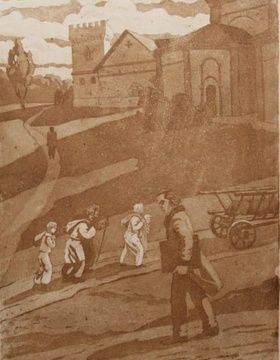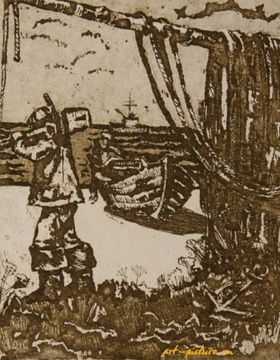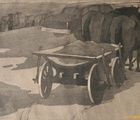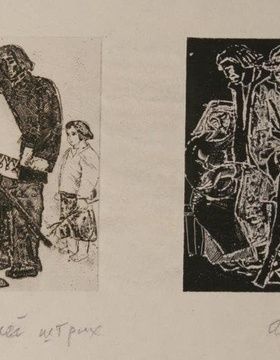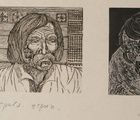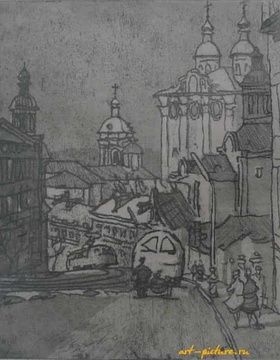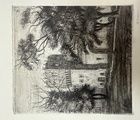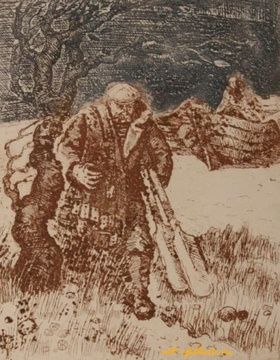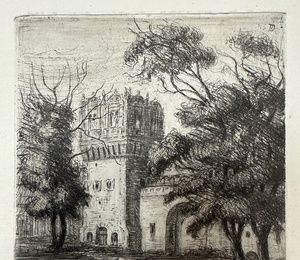Офорт: история возникновения и разновидности
Офорт: история возникновения и разновидности
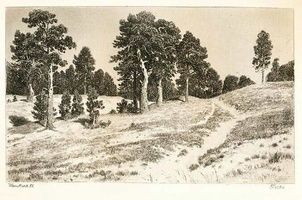
Офорт (фр. eau forte – крепкая вода) – разновидность гравюры, выполняемая на металле путем вытравливания азотной кислотой (для железа) или хлорного железа (для меди). Разновидность глубокой печати.
На полированную металлическую пластину (цинк, сталь, медь) наносится специальный грунт (офортный лак), устойчивый к воздействию кислот. Далее на «доске» специальной гравировальной иглой процарапывается рисунок. Обратная сторона пластины защищается от воздействия реагента битумным лаком. После этого она помещается в кислоту для вытравливания. При этом в процарапанных местах появляются углубления. Время от времени пластину вынимают для просушки и покрытия части изображения лаком, а затем опять помещают в реагент. Путем изменения времени нахождения «доски» в кислоте регулируют глубину вытравленных контуров. После окончания процесса вытравливания лак удаляют посредством растворителя. Далее пластину покрывают красителем и протирают. В результате получается готовая для нанесения оттисков «доска». Данный способ, как можно заметить, проще, чем те, которыми выполняется резная гравюра по металлу или ксилография (гравюра по дереву). При необходимости могут быть получены штрихи разной ширины и глубины, что дает возможность выполнить максимально детализированное изображение, практически не затрачивая никаких усилий, так как основную работу берет на себя кислота.
Описанный выше способ называется «травленый штрих» и считается наиболее распространенным. Изначально гравюры выполнялись единственно таким способом. Однако в разное время были изобретены и другие техники вытравливания.
• Мягкий лак – метод, появившийся в XVIII веке. Позволяет получать более свободный и легкий штрих, не такой резкий сухой, как при использовании иглы. Пластину покрывают мягким офортным лаком, что позволяет использовать достаточно слабую кислоту. Далее на нее накладывается бумага, на которой карандашом выполняется рисунок. При этом мастер может использовать жесткий или мягкий грифель, а также менять силу нажатия. В результате лак в местах контура изображения пристает к бумаге с обратной стороны. Эта техника является самой быстрой.
• Акватинта(фр. aquatinta – окрашенная вода). Изобретена в 1760 г. во Франции Жан-Батист Лепренсом. При выполнении гравюр пластина частично покрывается канифолью и помещается в кислоту. Далее вынимается и снова частично покрывается кислоупорным составом. Техника позволяет создавать тональные плоскости большого диапазона. Считается наиболее распространенным способом выполнения тона в офорте.
• Лавис (фр. lavis – растушевка). Также изобретен Лепренсом в XVII веке. На полированную поверхность, засыпанную акватинтой, наносится рисунок травящим составом, в который входит крепкая 40%-я кислота и красящее вещество, которое позволяет видеть рисунок в контурах и определять его по глубине тона. Рисование производится акварельными кистями или кистями из стекловолокна. Чем гуще положен травящий состав, тем глубже сила тона. Рисование свободное, без необходимости покрытия кислотоупорным лаком, что исключает появление на оттиске жестких границ у тоновых пятен. При качественной печати тиражная гравюра создает полное впечатление уникального акварельного рисунка. Подмена одной графической техники другой не всегда бесспорна, и художники, работающие в этой манере, применяют разные способы нанесения канифольного слоя с целью получения различной фактуры, что придает оттиску своеобразие и приводит к неоспоримым художественным результатам. В конечном итоге, современный лавис по своим внешним изобразительным характеристикам очень приближен к акватинте, но отличается от нее акварельностью тонового пятна, мягкостью и размытостью очертаний рисующих мазков. Так же, как и акватинту, лавис применяют в сочетании с другими манерами офорта, например, с сухой иглой. Техника требует соблюдения особой осторожности и позволяет получать ограниченное количество оттисков.
• Резерваж (фр. reservage – сохранение). Метод изобрел француз Ф. Жилло в 1850-х годах. Рисунок на металле производится посредством чернил, смешанных с сахаром, нанесенных кистью. Далее пластина покрывается офортным лаком и помещается в теплую воду. В результате чернила разбухают и поднимают частицы лака. Кислоупорный состав при этом несложно удалить в местах контуров. Подготовленная таким образом «доска» опускается в кислоту обычным способом. Готовые оттиски напоминают наброски кистью.
• Меццо-тинта (итал. mezzo tinto – умеренная тонировка). Техника изобретена немцем Людвигом фон Зигеном в 1642 году. Другое название – «английская манера» или «черная манера». Рисунок на обработанной особым методом пластине выполняется путем высветления отдельных участков. Для обработки доски используется специальный инструмент – качалка. Рисунок наносится с помощью трехгранного шабера. Техника позволяет передавать живописную манеру и имитирует мазок.
Впервые техника гравировки посредством вытравливания кислотой была использована аугсбургским мастером Даниэлем Хопфером в 1501 году. Приблизительно в это же время другой художник – Альбрехт Дюрер – выполняет шесть офортов, используя при этом стальную доску. Самым известным из первых гравюр этого мастера произведением считается «Большая пушка». Этими граверами использовались стальные пластины. Однако уже в первой половине XV века становятся известными техники выполнения офорта на меди, после чего этот металл на долгое время становится основным, используемым для гравировки.
Как вид искусства офорт достигает своего расцвета только в XVII веке. В это время данную технику активно используют в основном французские, итальянские и голландские мастера. В Голландии этот вид рисунка приравнивается даже к настоящей живописи. Большой вклад в развитие офорта и его исключительное признание внес Рембрандт Харменс ван Рейн (1606 – 1669 гг.). Работы этого мастера до сих пор считаются непревзойденными образцами графического искусства. Одновременно с Рембрандтом в технике офорта работают такие мастера, как Я. Ливенс, А. Остаде, К. Бега, Э. Вельде и многие другие. Особо стоит отметить портретные гравюры, выполненные травлением, А. ван Дейка. Наряду с этими мастерами свой вклад в развитие офорта вносит и Ж. Калло, один из известнейших на сегодня граверов, выполнивший более полутора тысяч работ в этой технике. Современная техника гравюры этого типа отличается необыкновенным разнообразием манер. Художники постоянно совершенствуют ее и, экспериментируя, создают все новые и новые методы.
Офорт (в переводе с фр. «крепкая вода») – это разновидность печатной графики. Техника предполагает создание рисунка на металлической поверхности путем протравливания азотистой кислотой линий и других элементов изображения, после чего на печатную форму наносится краска и накладывается специальная бумага. Долговечность металла дает возможность повторять процесс печати бесконечное количество раз. В течение столетий офорт активно использовался европейскими мастерами для создания иллюстраций и самостоятельных произведений искусства.
ИСТОРИЯ ИЗОБРЕТЕНИЯ ТЕХНИКИ
Первые офорты были изготовлены в начале XVI века. Новая техника стала альтернативой традиционной гравюре, изготавливавшейся при помощи резцов. Ноу-хау стало настоящим прорывом: теперь мастер работал только со слоем кислоупорного лака, нанесенного на поверхность металлической доски, а остальное за него делала азотистая кислота. Применение новой техники давало возможность граверам создавать сложные изображения большими тиражами.
Согласно тексту дворянской грамоты императора Рудольфа II, автором первых офортов был Даниэль Хопфер из Аугсбурга. Ему принадлежит целая серия печатной графики (портреты, пейзажи, мифологические и религиозные сюжеты). Творчество Хопфера получило признание современников, поэтому еще при жизни мастера офорты стали предметами коллекционирования. После первых успехов новой техники ее взял на вооружение Альбрехт Дюрер. На металлических и медных пластинах он создал множество работ, славящихся своим композиционным совершенством и тщательной проработкой деталей.
Параллельно с немецкими граверами технику офорта развивали и в других странах Европы. В Голландии наибольших успехов достигли Х. Сегерс, П. Поттер и Рембрандт. Здесь офорт использовался как при создании портретов аристократов, так и печати панорам сельской местности для украшения домов купцов. В Италии технику освоили мастера городского пейзажа Дж. Б. Тьеполо, Дж. Б. Пиранези. С ее помощью они создавали большим тиражом картинки «ведуты» с изображением архитектурных панорам Венеции и других городов. Художественная ценность такого творчества была не высокой, но туристы их охотно покупали в качестве сувениров.
Новый импульс к развитию офорт получил после возникновения импрессионизма. Возможности техники травленого штриха высоко оценили О. Ренуар, Клод Моне, Эдуард Мане и другие. Отдельно также следует упомянуть английского гравера У. Блейка. Ему удалось придать отпечатанным изображениям еще большей глубины и выразительности благодаря сочетанию принципов глубокой и высокой печати, а также постпечатной раскраски листов. Начиная с ХХ века, офорт уступает место другим видам печати, все больше превращаясь в диковинку. Сегодня его используют вместе с другими техниками для создания оригинальных произведений искусства.
ТЕХНИКА ОФОРТА
В качестве заготовки для печатной формы используется медная или цинковая пластина. Сначала ее выравнивают, устраняя все неровности. Затем поверхность покрывают слоем устойчивого к кислоте лака. На поверхности гравер выполняет рисунок и выцарапывает его иголочками. Чем толще должна быть линия, тем глубже нужно процарапать штрих. После этого заготовку помещают в ванночку с азотистой кислотой и ждут несколько часов, пока она протравит металл в местах царапин. Для создания сложных композиций процесс лакировки и травления могут повторять несколько раз.
На финальном этапе подготовки печатной формы ее поверхность очищают от лака и просушивают. После этого при помощи ракеля на поверхность пластины наносится специальные чернила, а затем ее накрывают офортной бумагой. Отпечатанный лист аккуратно снимают и просушивают. Процесс можно повторять бесконечное количество раз, но при этом следует помнить, что каждый новый отпечаток будет слегка отличаться от предыдущих. На арт-рынке больше всего ценится первая отпечатанная копия с новой формы.
ИЗВЕСТНЫЕ МАСТЕРА ОФОРТА
Массовое увлечение техникой наблюдалось вплоть до изобретения более современных методов эстампа, основанных на применении новых материалов. Несмотря на это, даже в ХХ веке известные художники продолжали создавать офорты.
Пабло Пикассо
Известный испанский художник славился своей любовью к экспериментам с различными техниками изобразительного искусства. Неудивительно, что в его творческом наследии можно найти немало интересных гравюр, выполненных в технике офорта. Представление о стиле мастера нам дает одна из его гравюр под названием «Женщина с бубном» (1939). В работе Пикассо в стиле Ню отчетливо прослеживается влияние художественных принципов кубизма и сюрреализма. Офорт стал еще одной вехой творческого пути мастера.
Эдгар Дега
Даже в технике офорта художник оставался верным принципам импрессионизма. Наиболее ярко эту особенность стиля Дега иллюстрирует гравюра «Портрет Маргариты де Га» (1865). Благодаря травлению перекрестных штрихов мастеру удалось создать эффект глубины пространства и усилить контраст между темным фоном и светлым лицом молодой девушки. В технике травленого штриха Дега создавал портреты и пейзажи.
Франсиско Гойя
При помощи глубокой печати Гойя создал серию интересных работы под названием «Капричос». В нее вошло около 80 гравюр, напечатанных не позднее 1799 года. При помощи фантазийных сюжетов и существ Гойя предлагает зрителю поразмышлять над парадоксами и причудливыми поворотами человеческой жизни. Гравюры несут на себе отпечаток мрачноватого мироощущения художника.
Альбрехт Дюрер
Немецкий мастер с особой тщательностью прорабатывал каждую деталь эстампа. Результатом его стараний стали сотни великолепных гравюр на религиозную и светскую тематику. Представление о Дюрере как о гравере дает серия работ под названием «Апокалипсис». В нее вошло 15 больших листов с изображениями и текстами на обратной стороне. Выбор тематики был для Дюрера неслучаен. Апокалиптические сюжеты пользовались огромной популярностью в Германии XV-XVI вв. в связи с политической раздробленностью и социальной нестабильностью немецких княжеств.
Рембрандт
Офорты для Рембрандта стали любовью всей жизни. Помимо своих работ он также коллекционировал гравюры других мастеров. Фанатичность, с которой художник подходил к занятиям искусством, не позволяла ему представлять публике офорты, которые, по его мнению, являлись далекими от совершенства. Из-за этого он по многу раз мог переделывать печатную форму, тщательно прорабатывая каждый штрих. К примеру, над офортом «Христос, исцеляющий больных (Лист в сто гульденов)» мастер работал в течение 7 лет. На сегодняшний день известно о 289 работах Рембрандта.
Уильям Блейк
Автор техники рельефного офорта в глазах современников выглядел чудаковатым романтиком. Но это досадное обстоятельство не мешало Блейку посвятить себя гравюрам с замысловатым сюжетом. С огромным терпением и внимательностью мастер прорабатывал каждую деталь. Старания Блейка вознаграждались потрясающими по своей глубине и качеству гравюрами, максимально удаленными от печатного мейнстрима. Блейк использовал свои знания и навыки при создании авторской книги. Отпечатанными в ней были не только изображения, но и тексты. Для усиления выразительности оттиски дополнительно раскрашивались при помощи акварельных красок. После Блейка свои авторские книги начали создавать и другие деятели искусства.
Аукцион искусства и старины art-picture.ru предоставляет возможность покупки
приобрести представленны лоты по теме "Офорт: история возникновения и разновидности"
